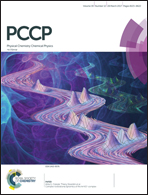Dielectric relaxation and localized electron hopping in colossal dielectric (Nb,In)-doped TiO2 rutile nanoceramics
Abstract
Dielectric spectroscopy was performed on a Nb and In co-doped rutile TiO2 nano-crystalline ceramic (n-NITO) synthesized by a low-temperature spark plasma sintering (SPS) technique. The dielectric properties of the n-NITO were not largely affected by the metal electrode contacts. Huge dielectric relaxation was observed at a very low temperature below 35 K. Both the activation energy and relaxation time suggested that the electronic hopping motion is the underlying mechanism responsible for the colossal dielectric permittivity (CP) and its relaxation, instead of the internal barrier layer effect or a dipolar relaxation. With Havriliak–Negami (H–N) fitting, a relaxation time with a large distribution of dielectric relaxations was revealed. The broad distributed relaxation phenomena indicated that Nb and In were involved, controlling the dielectric relaxation by modifying the polarization mechanism and localized states. The associated distribution function is calculated and presented. The frequency-dependent a.c. conductance is successfully explained by a hopping conduction model of the localized electrons with the distribution function. It is demonstrated that the dielectric relaxation is strongly correlated with the hopping electrons in the localized states. The CP in SPS n-NITO is then ascribed to a hopping polarization.



 Please wait while we load your content...
Please wait while we load your content...